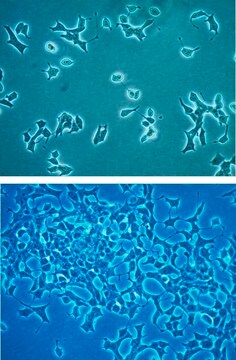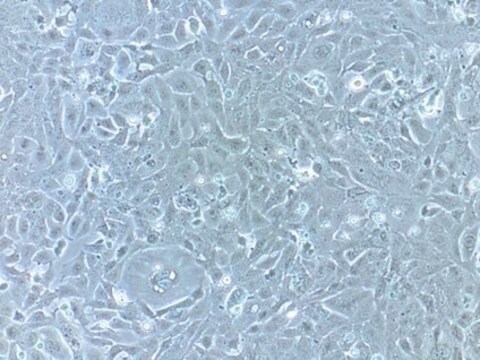SCC412
LbetaT2 Mouse Pituitary Gonadotrope Cell Line
Mouse
Zaloguj sięWyświetlanie cen organizacyjnych i kontraktowych
About This Item
Kod UNSPSC:
41106514
NACRES:
NA.45
Polecane produkty
product name
LbetaT2 Mouse Pituitary Gonadotrope Cell Line,
pochodzenie biologiczne
mouse
opakowanie
vial of >1X10⁶ cells
producent / nazwa handlowa
Millipore
tryb wzrostu
N/A
metody
cell culture | mammalian: suitable
Warunki transportu
dry ice
temp. przechowywania
≤ − 140°C
Zastosowanie
Gonadotropin-releasing hormone (GnRH) plays a key role in the control of reproduction in mammals. GnRH acts via its receptor, GnRH-R, to trigger the synthesis and release of luteinizing hormone (LH) and follicle-stimulating hormone (FSH) by the pituitary gonadotropes. In turn, the gonadotropins regulate gametogenesis and steroidogenesis in the gonads. LH and FSH comprise a common glycoprotein hormone subunit, CGA, and the respective specific subunits LH and FSH. The individual subunits bind noncovalently to the common a subunit to form the mature glycoprotein hormones. Lhb gene expression is preferentially induced by high-frequency GnRH pulses, whereas low-frequency pulses favor Fshb expression.
Source.
The immortalized L(betta)T2 mouse pituitary gonadotrope cell line was generated by targeted tumorigenesis in transgenic mice carrying the rat LHb regulatory region linked to the SV40 T-antigen oncogene.1 L(betta)T2 cells express CGA, GnRH-R, and LHb. The cell line responds to pulsatile GnRH stimulation by upregulating Lhb and Gnrhr and secreting LH. The L(betta)T2 cell line has been widely used as an in vitro model for the study of gonadotropin gene regulation and GnRH signaling.2,3,4,5 The global mRNA expression profile and a genome-wide atlas of accessible chromatin in GnRH-stimulated L(betta)T2 cells has recently been described6 and the STR profile has also been reported.7
References
Note: Please include the appropriate references from 1-5 in your publications that utilize them.
1. Alarid ET, Windle JJ, Whyte DB, Mellon PL. Development 1996; 122(10):3319-3329.
2. Turgeon JL, Kimura Y, Waring DW, Mellon PL. Molecular Endocrinology 1996; 10(4):439-450.
3. Thomas P, Mellon PL, Turgeon J, Waring DW. Endocrinology 1996; 137(7):2929-2989.
4. Alarid ET, Holley S, Hayakawa M, Mellon PL. Mol Cell Endocrinol 1998; 140(1-2):25-30.
5. Pernasetti F, Vasilyev VV, Rosenberg SB, Bailey JS, Huang HJ, Miller WL, Mellon PL. Endocrinology 2001; 142(6):2284-2295.
6. Ruf-Zamojski F et al. Front Endocrinol (Lausanne) 2018; 9:34.
7. Ruf-Zamojski F et al. J Endocr Soc 2019; 3(5):902–920.
Source.
The immortalized L(betta)T2 mouse pituitary gonadotrope cell line was generated by targeted tumorigenesis in transgenic mice carrying the rat LHb regulatory region linked to the SV40 T-antigen oncogene.1 L(betta)T2 cells express CGA, GnRH-R, and LHb. The cell line responds to pulsatile GnRH stimulation by upregulating Lhb and Gnrhr and secreting LH. The L(betta)T2 cell line has been widely used as an in vitro model for the study of gonadotropin gene regulation and GnRH signaling.2,3,4,5 The global mRNA expression profile and a genome-wide atlas of accessible chromatin in GnRH-stimulated L(betta)T2 cells has recently been described6 and the STR profile has also been reported.7
References
Note: Please include the appropriate references from 1-5 in your publications that utilize them.
1. Alarid ET, Windle JJ, Whyte DB, Mellon PL. Development 1996; 122(10):3319-3329.
2. Turgeon JL, Kimura Y, Waring DW, Mellon PL. Molecular Endocrinology 1996; 10(4):439-450.
3. Thomas P, Mellon PL, Turgeon J, Waring DW. Endocrinology 1996; 137(7):2929-2989.
4. Alarid ET, Holley S, Hayakawa M, Mellon PL. Mol Cell Endocrinol 1998; 140(1-2):25-30.
5. Pernasetti F, Vasilyev VV, Rosenberg SB, Bailey JS, Huang HJ, Miller WL, Mellon PL. Endocrinology 2001; 142(6):2284-2295.
6. Ruf-Zamojski F et al. Front Endocrinol (Lausanne) 2018; 9:34.
7. Ruf-Zamojski F et al. J Endocr Soc 2019; 3(5):902–920.
Cechy i korzyści
The LbetaT2 cell line has been widely used as an in vitro model for the study of gonadotropin gene regulation and GnRH signaling
Przechowywanie i stabilność
The cells should be stored in liquid nitrogen. The cells can be cultured for at least 10 passages after initial thawing without significantly affecting the cell marker expression and functionality.
Inne uwagi
This product is intended for sale and sold solely to academic institutions for internal academic research use per the terms of the “Academic Use Agreement” as detailed in the product documentation.
Oświadczenie o zrzeczeniu się odpowiedzialności
Unless otherwise stated in our catalog or other company documentation accompanying the product(s), our products are intended for research use only and are not to be used for any other purpose, which includes but is not limited to, unauthorized commercial uses, in vitro diagnostic uses, ex vivo or in vivo therapeutic uses or any type of consumption or application to humans or animals.
This page may contain text that has been machine translated.
Kod klasy składowania
10 - Combustible liquids
Klasa zagrożenia wodnego (WGK)
WGK 2
Temperatura zapłonu (°F)
Not applicable
Temperatura zapłonu (°C)
Not applicable
Certyfikaty analizy (CoA)
Poszukaj Certyfikaty analizy (CoA), wpisując numer partii/serii produktów. Numery serii i partii można znaleźć na etykiecie produktu po słowach „seria” lub „partia”.
Masz już ten produkt?
Dokumenty związane z niedawno zakupionymi produktami zostały zamieszczone w Bibliotece dokumentów.
Nasz zespół naukowców ma doświadczenie we wszystkich obszarach badań, w tym w naukach przyrodniczych, materiałoznawstwie, syntezie chemicznej, chromatografii, analityce i wielu innych dziedzinach.
Skontaktuj się z zespołem ds. pomocy technicznej







